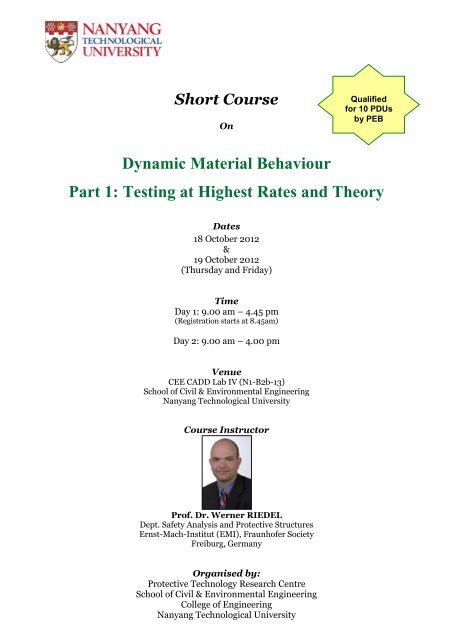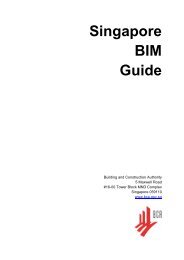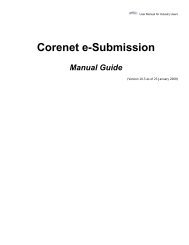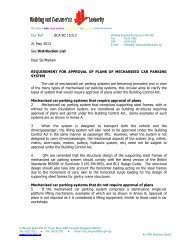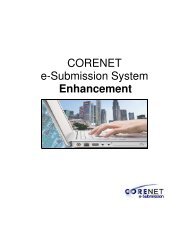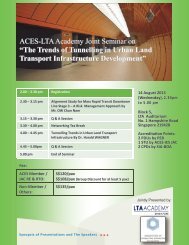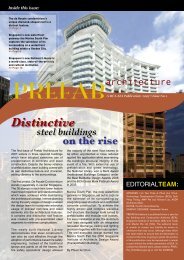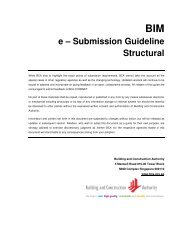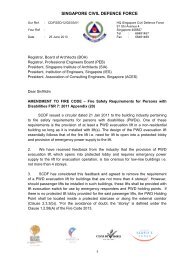Event id: 3796915698618372037 (0) - Corenet
Event id: 3796915698618372037 (0) - Corenet
Event id: 3796915698618372037 (0) - Corenet
You also want an ePaper? Increase the reach of your titles
YUMPU automatically turns print PDFs into web optimized ePapers that Google loves.
Short CourseOnQualifiedfor 10 PDUsby PEBDynamic Material BehaviourPart 1: Testing at Highest Rates and TheoryDates18 October 2012&19 October 2012(Thursday and Fr<strong>id</strong>ay)TimeDay 1: 9.00 am – 4.45 pm(Registration starts at 8.45am)Day 2: 9.00 am – 4.00 pmVenueCEE CADD Lab IV (N1-B2b-13)School of Civil & Environmental EngineeringNanyang Technological UniversityCourse InstructorProf. Dr. Werner RIEDELDept. Safety Analysis and Protective StructuresErnst-Mach-Institut (EMI), Fraunhofer SocietyFreiburg, GermanyOrganised by:Protective Technology Research CentreSchool of Civil & Environmental EngineeringCollege of EngineeringNanyang Technological University
~~~ COURSE OUTLINE ~~~Material descriptions for predictive simulations of transient dynamic processes (eg. crash, shock loading andimpact) require a broad knowledge of experimental, analytical and numerical basics, such as:- Theory of equation of state for sol<strong>id</strong> materials- Wave propagation analysis of dynamic triaxial deformation processes- Static and dynamic experimental characterisation procedures- Suitable state-of-the-art and development stage material models- Governing equations and suitable discretisation for large deformations, failure and post-failure behaviourA four-day course focused to anchor and broaden these basics in view of predictive simulation capabilities forscientists and engineers has been developed over the last decade by scientific staff of Ernst-Mach-Institut. It isstructured into two sessions of two days each:- Dynamic Material Behaviour Part I: High Rate Testing and Theory- Dynamic Material Behaviour Part II: Simulation of Metals, Concrete and CompositesPart I of the course focuses on the phenomenology of the dynamic behaviour of materials, the testing methodsand the theories for description in constitutive models. Necessary basics on mechanics of materials andcontinuum mechanics are slowly introduced and kept at a pragmatic level. Chosen testing and modellingprocedures are being prepared as hands-on examples and exercises. Part I is designed with the conclusionsection (part 00) to be useful as a stand-alone course. Part II of the course is scheduled for Spring 2013.~~~ COURSE CONTENT ~~~18 October 2012, Thursday 19 October 2012, Fr<strong>id</strong>ayPart I: Introduction- Fraunhofer, EMI, Presenter- Strain rates in applications, Exercise 1- Global/local instability, Optical strain measurements- Exercise 2: Dynamic instabilityPart II: Dynamic Stress Wave Analysis- 1D Elastic stress wave, Hopkinson-Bar, Taylor-Test- Exercise 3: Taylor-Test with HydrocodePart III: Constitutive Models of Dynamic Strength- Eq. stress and strain, Flow potential- Constitutive Models of dynamic strength- Exercise 3b: Strain and strain rate hardening, FailurePart 0: Repetition- Key findings and contexts from Day 1Part IV: Shock Waves in Sol<strong>id</strong>s- Compression/shock wave, plate impact, contactdetonation- Deriving the equation of state- Direct/ inverse plate impact, Lagrange & X-t-Diagram- Exercise 4: Simulating plate impact testsPart 00: Conclusion- Chosen Applications- Summary- Outlook on Part II of the Course: Simulation ofmetals, concrete and composites~~~ WHO SHOULD ATTEND ~~~This course has been developed to primarily serve Engineers and physicists, who need a working knowledge ofdynamic design calculations for security and protection applications. The course is also applicable to staff ofProcurement Agencies, Contractors and Designers in the area of defence and security.Werner RIEDEL Prof, Dr.-Ing.~~~ ABOUT THE INSTRUCTOR ~~~Professor Werner Riedel (born 1970) is Deputy Head of the Department of SafetyTechnology and Protective Structures of EMI. He received degrees in MechanicalEngineering from the Technical Universities of Munich (1994) and Compiègne, France(1996). At EMI he specialised in numerical modelling of materials and components underdynamic loads. In 2000 he received the doctoral degree at the University der Bundeswehr atMunich (modeling concrete, RHT). Among the numerous projects (>100) are industrial andpublic customers such as EADS, ESA, European Commission, BMW, Areva. Prof. Riedelpublished 70 scientific publications (1996 – 2012). He was twice invited as Visiting Professorto TokyoTech (2006/2010) and lectures as Honorary Professor at Furtwangen University inthe discipline ‘Security & Safety Engineering’.
Short Course DetailsDate18 October 2012 (Thursday) andTimeDay 1: 9.00 am – 4.45 pm19 October 2012 (Fr<strong>id</strong>ay)(registration starts at 8.45 am)Day 2: 9.00 am – 4.00 pmVenueCEE CADD Lab IV, Block N1, #B2b-13School of Civil & Environmental EngineeringNanyang Technological UniversityFeesS$600/- per person Fees include 7% GST, refreshments, lunch, & course materials. Please send the registration form with payment at least 10 working days before thecommencement of the short course. There will be no refund of fees for any cancellation made. A replacement can be madeat no extra charge. Registration will only be confirmed upon the receipt of the registration form.Registration FormOrganisationAddressContact PersonTel no.EmailFax no.We wish to register for the following person(s)1. Name DesignationEmailContact No.2. Name DesignationEmailContact No.3. Name DesignationEmailContact No.Payment Mode:Cheque: (bank/no. …………………….)Amount: S$...................To invoice company (if required): ……………………………………………………Cheque payable to “Nanyang Technological University” and mail itTo : Protective Technology Research CentreNanyang Technological UniversitySchool of Civil & Environmental EngineeringBlk N1.1-B3-03, 50 Nanyang Avenue, Singapore 639798Tel: 6790 5285Attn to: Ms Debbie LowFor registration and enquiries, please send your email to d-ptrc@ntu.edu.sg .


